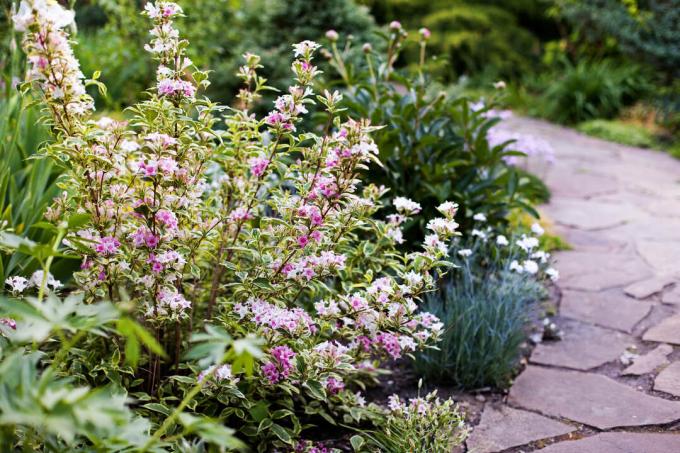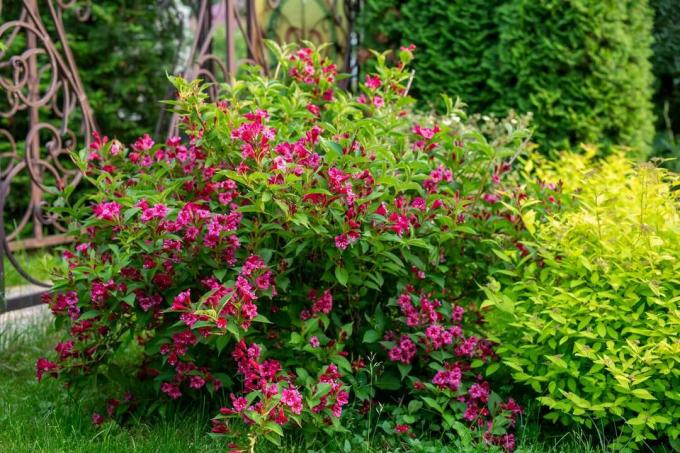The easy-care weigela enchants with its colorful abundance of flowers. This hardy ornamental shrub doesn't need much to thrive successfully.

The deciduous weigela (Weigela) is a real eye-catcher both in the garden and in the tub on the terrace or balcony. It impresses with two characteristics in particular: its beauty and its frugality. In this article we will show you what the weigela needs in order to be able to develop its abundance of flowers.
Contents
-
Weigela: origin and characteristics
- When do weigela bloom?
- Are weigela bee friendly?
-
Planting weigela: location and procedure
- The optimal location for weigela
- Planting Weigela: This is how you do it
- Plant weigela hedges
- Plant weigela in the bucket
- Important care measures
- Is the weigela hardy?
- Is the weigela poisonous?
Weigela: origin and characteristics
The deciduous ornamental tree belongs to the honeysuckle family (Caprifoliaceae) and originally comes from northeast Asia, more precisely from Japan, Korea, China and parts of Russia. There weigela grow mainly in mixed forests and bushes. Since the 19th They have been cultivated as ornamental trees in European parks and gardens for centuries. The genus
Weigelia With around 12 species and the resulting varieties, offers woody plants with different leaf colors - from green to multicolored leaves to reddish foliage.The situation is similar with the flowers, which can be white, pale pink or colored in a delicate yellow. The growth form of Weigela varieties and species however, is similar – mostly sparse with long overhanging flower spikes and an overall upright habit. Its deciduous leaves are elliptical in shape, arranged opposite and short to sessile. The shape of the flowers is calyx to funnel-shaped and is reminiscent of a bell. For this reason, the weigela is also called bell bush.
The Weigela looks confusingly similar to the Kolkwitzie (Kolkwitzia amabilis). The distinction succeeds by looking at the flowers:
- Flower shape: The flowers of the Weigela are funnel-shaped, while the Kolkwitzia has elongated, trumpet-shaped flowers that are yellow on the inside.
- Flowering time: Both plants flower in May. However, the weigela can bloom later in the year.
- Petals: The petals of the weigela are pointed and evenly spaced. The Kolkwitzia, on the other hand, has five rounded petals, two more towards the top and three towards the bottom.
When do weigela bloom?
The main flowering period of the weigela is between May and June. Various varieties even bloom into August. If the first flowering is over, there may also be a somewhat weaker subsequent flowering. In order to promote the second bloom, the old flower clusters are cut back.
After the flowering period, the capsule fruits of the weigela ripen, which can be harvested and used for sowing. Alternatively, there are two much simpler methods of propagation - we explain how to use them in our special article propagate weigela can.

Weigela 'Bristol Ruby' Ruby red
- Gorgeous ruby red flowers from May to July & repeat flowering in autumn
- Decorative color change in autumn: from green to golden yellow
- Easy-care & robust: as a flowering hedge or as a solitary plant in the garden
Are weigela bee friendly?
Yes, the bell-shaped flowers of the weigela attract bees. It serves as an important food source for insects during the flowering period.

Planting weigela: location and procedure
Weigelia do not have high demands and are therefore easy-care garden dwellers. When, where and how to plant the ornamental shrub, you will learn below.
The optimal location for weigela
The Weigela is very frugal when it comes to its location. It prefers a place with plenty of sunlight and humus-rich, nutrient-rich and well-drained soil, which can be slightly acidic to alkaline. Make sure that the substrate neither dries out nor tends to become waterlogged. It can grow just as well in a partially shaded location, but flowers less lavishly there.

Planting Weigela: This is how you do it
The best time for planting is in spring. To do this, dig a planting hole that is about one and a half times as deep as the size of the ball. In the case of a solitary plant, the ornamental shrub should be given a little more space and a distance of around 2 m to the neighboring plants should be planned. If the chosen location tends to become waterlogged, it is advisable to create a drainage layer of gravel or grit before inserting the plant. Once the weigela is placed, the gaps can be filled with topsoil and the freshly planted weigela can be watered. Suitable plant neighbors are, for example splendor spars (astilbe), Kolkwitzien (Kolkwitzia amabilis) or mock orange (Philadelphus coronarius). Suitable as underplanting cranesbill (geranium), foam flowers (Tiarella), hosts (hosta), avens (geum) and wood anemone (Anemone nemorosa).

Plant weigela hedges
The Weigela is particularly suitable as an informal, loosely growing hedge, for example as a border between gardens. Ideally, the shrub is planted in spring between April and May so that the ornamental tree can root well until winter. Below we show how you can plant the weigela as a hedge:
- Dig a furrow at desired location, about 1½ times as deep as root pad
- Loosen the soil generously, for example with a digging fork
- Plant weigela plants at a distance of 1 - 1.5 m from each other
- Fill in the gaps with soil
- Water well
Plant weigela in the bucket
The weigela is not only excellent as a hedge plant, the perennial ornamental tree can also be cultivated in tubs. Small species and varieties are particularly suitable for this. As a substrate, we recommend a high-quality potting soil such as our peat-free Plantura organic potting soil. The expanded clay it contains ensures optimal structure and permeability - potassium and phosphorus stimulate lush flowering.

Organic potting soil 40 L
- Ideal for all flowering plants in beds and pots
- Provides a lush & long-lasting bloom
- Peat-free & climate-friendly: CO2-reduced organic soil made in Germany
Depending on the size of the plant, care should be taken to ensure that the pot is appropriately sized, with the pot having a diameter of at least 40 cm.
Important care measures
Weigela are very robust and easy to care for. Plants in pots should be fertilized regularly, but only from March to August, with a liquid fertilizer such as ours Plantura organic flower & balcony fertilizer be taken care of. The nutrients it contains not only ensure healthy plant growth, but also lush flowering.

Organic flower & balcony fertilizer 800 ml
- Organic organic liquid fertilizer for all flowers and balcony plants
- For lush blooms throughout the season
- Quick & easy watering application - safe for pets & garden animals
A pruning is not absolutely necessary. In order to achieve a compact growth, a gentle topiary is recommended after the shrub has finished flowering. You can cut back the faded shoots to the next branch fork or dormant bud. The reblooming in autumn is not endangered, because this takes place on this year's wood. In our special article we explain which pruning measures are possible and what you can also do with the cutting the weigela should consider.

Is the weigela hardy?
Yes, the Weigela is hardy in itself and does not need any protection in the garden in winter. In the bucket, however, the plant needs some attention because its roots are not sufficiently protected in the pot. It is best to place your weigela against the wall of the house and wrap the plant in fleece or jute. In addition, a layer of mulch on the ground protects against severe frosts. If the last late frosts in May are over, you can put the plant back in its usual place.
Is the weigela poisonous?
All parts of the weigela are not poisonous to humans, dogs or cats and can therefore be planted in the garden or on the balcony without hesitation. Nevertheless, it is an ornamental tree, which is why the consumption of all parts of the plant is not recommended.
Another splendidly flowering ornamental plant that is suitable as a beautiful hedge is the smoke bush (Cotinus coggygria) – we have briefly and concisely summarized which varieties this species offers and how the shrub is pruned.
Register now for the Garten-Post and receive great tips, seasonal trends and inspiration on everything to do with the garden from our expert every week.



